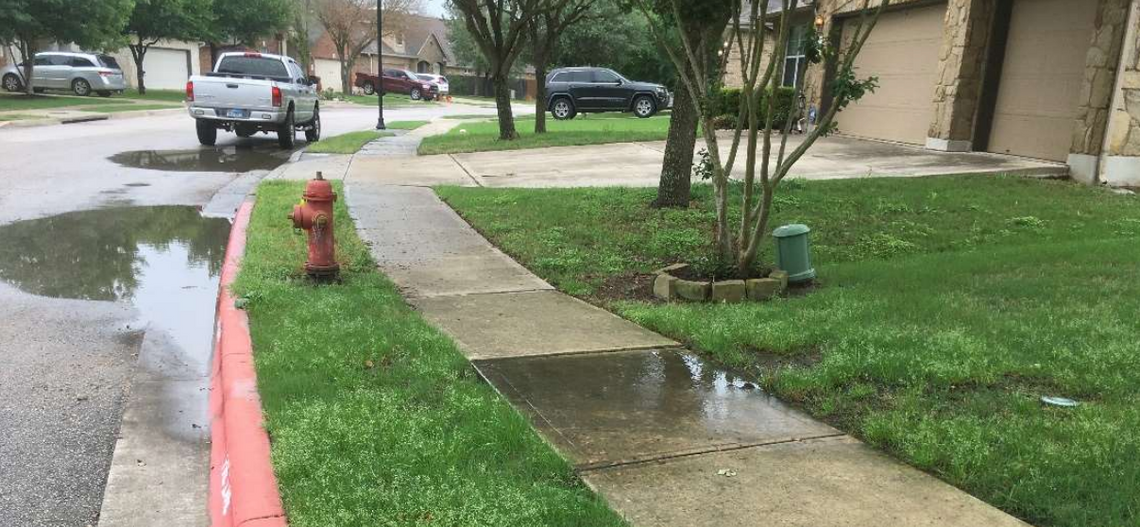By Brittany Anderson
BUDA -- After years of dealing with foundation cracks, constantly-flooded backyards and unlevel streets and driveways, a handful of residents in the southeast portion of Buda's Whispering Hollow subdivision may soon find some relief.
Following a groundwater study conducted by Aqua Strategies Inc. (ASI), a water planning and engineering company, a meeting between some of the subdivision's affected residents and officials in the city's engineering and public works department took place on Jan. 10 to discuss the study's findings and form an 'implementation committee.'
ASl's study was included in the city's 2021 Capital Improvements Plan, and the establishment of the committee was requested by the city council in order to further investigate the issue and come to a solution.
Several Whispering Hollow residents have experienced shallow saturated ground conditions, some dating as far back as 2008, that have caused a myriad of water-related problems for their homes.
Many have installed multiple sump pumps or made other drainage modifications, but the problem persists: excess water is discharged into yards or onto the street and sidewalks, causing yard flooding and the cracking and shifting of curbs, road surfaces and foundations.
Discharge from a sump pump on Lillie Robyn Ln that has pooled in the yard, on the sidewalk and into the street. Photo via Aqua Strategies study.
Per ASl's study, throughout 2021, ASI staff conducted field observations, pump tests and drilled 12 boreholes, concluding that geologic conditions are the source of the problems and confirming that residential-grade solutions (like drains and pumps) implemented so far have been ineffective in mitigating the issues.
The study area (pink) with highlighted areas where persistent storm sewer flow (dark blue) and shallow saturated conditions at homes (light blue) are a concern. The red circles indicate homes of residents who have reported seepage issues. Photo via Aqua Strategies study.
Prior to the subdivision's construction, a report by BSEACD (Barton Springs Edwards Aquifer Conservation District) geologist Brian Hunt identified historical springs and seeps in the area, which explains that the conditions homeowners are facing today are caused by perched aquifers.
A perched aquifer occurs when surface water infiltrates a porous medium that sits on top of an impermeable material, causing the water to build up.
The report also showed evidence of faulting in the area, which could explain why only some of the properties are experiencing this problem.
ASl's study provided four options for a solution. Everyone present at the meeting agreed that its first option of 'take no further option' was not feasible.
Option 2 consists of changing the drainage configuration of sump pump discharges to tie into existing storm sewer inlets. The estimated cost is $7,000 to $15,000 per sump pit, with an estimated total of $150,000 for ten total installations.
Options 3 and 4 both consist of dewatering the perched aquifers. For option 3, the city would construct a dewatering installation at an estimated cost of $350,000 to $525,000, excluding long-term operations and maintenance costs. For option 4, since the issue is only affecting a handful of homes, the city would help guide residents in individually modifying their sump pumps to make dewatering efforts more effective.
ASI staff advised that dewatering could lead to further shifting of foundation slabs, so the city would need to consult with a structural engineer to devise a plan for these improvements.
One resident at the meeting denounced option 4, saying that the burden of the cost of dewatering should not be placed on the homeowners.
Per the study, any combinations of options 2, 3 and 4 could be implemented by the city in order to maximize the longevity of the solution.
James Fort, one of the most affected residents who has been , offered his own solution during the meeting: that residents living in the 'bad areas' be bought out of their homes, as these issues have rendered their homes practically unsellable.
Water underneath Fort’s home. Photo by Sahar Chmais.
"There's a place to build homes and a place to not build homes," Fort said. "They OK'd it the building of the subdivision] with this [Hunt's] study. What they did was wrong, and you all know that deep down in your heart."
The formation of the committee was discussed during the meeting and is still in the process of selecting members. City officials and residents agreed that being transparent and communicative with each other was important as they move towards a solution.











